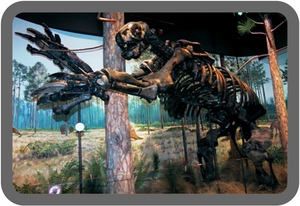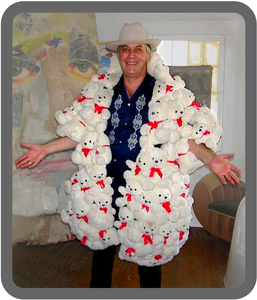
Larry Harvey sports a furry bear coat made by Dale East. Photo: John Barry

It is not known why Larry Harvey, along with Jerry James, constructed and burned an effigy of a man on the Baker Beach in San Francisco in 1986. Rumors suggest it was an homage to Harvey's father, or a response to romantic misadventure. Regardless of its origins, the event immediately sparked interest. One account:
"In the instant that the 8-foot tall figure was ignited, people scattered all across the beach came running. Within moments, a circle of fire-lit faces had formed, strangers who had gathered to witness this image of a man on fire. The first recorded doubling of Burning Man's community had occurred."
Between 1986 and 1989 a nascent community developed around the annual event on Baker Beach. Each year Harvey and James, later joined by John Law, Michael Michael and a small cadre of craftsmen, constructed and burned a man. By 1990 the event had outgrown Baker Beach. A participant reported:
"On the trip down to the beach in 1990, individuals bearing Burning Man's arms and head and the bulky wooden footings that were used to anchor him securely in the sand encountered a uniformed motorcycle policeman... A deal was struck and cemented with a handshake. Participants might erect the giant statue, he informed the organizers, but it could not be burned."The man was dismantled and stored. The San Francisco Cacophony Society had been holding small events in the Black Rock Desert. It was decided that the wide open expanse of a dry lake bed would be an ideal location to burn the now 40-foot tall man. Mean- while a tenant of the space where the man's legs and torso were stored cut up these parts for an unrelated project. The man was rebuilt in all night sessions and completed just in time for transport to Black Rock Desert.
Apart from notable exceptions, the use of money in the city is discouraged. A gift economy, in which participants give without expectation of renumeration, has developed. Display of corporate brands is also discouraged, and companies are prohibited from advertising or selling products inside city limits.
During the 1990s the city developed Departments of Public Works and Mutant Vehicles, as well as newspapers (notably Piss Clear), an airport, and a full complement of emergency services.
The Black Rock City Rangers, founded in 1992 by Michael Michael (aka Danger Ranger), are "dedicated to their role as non-confrontational mediators and providing an alternative to traditional law-enforcement models". Rangers patrol in pairs and are identifiable by their distinctive khaki shirts and Australian-styled hats. Rangers also frequently wear kilts.
The art of Burning Man spans the gamut of human expression. Many large structures are built and burned during the event. On Saturday night the Man is burned. In 2000, David Best built the first temple structure, which provided a place to record messages of personal significance, frequently to those who are no longer living. David Best built subsequent temples through 2004, after which Mark Grieve took over. The temple is burned on Sunday night, the last official night of the event, providing a somber close to the week's revelry.
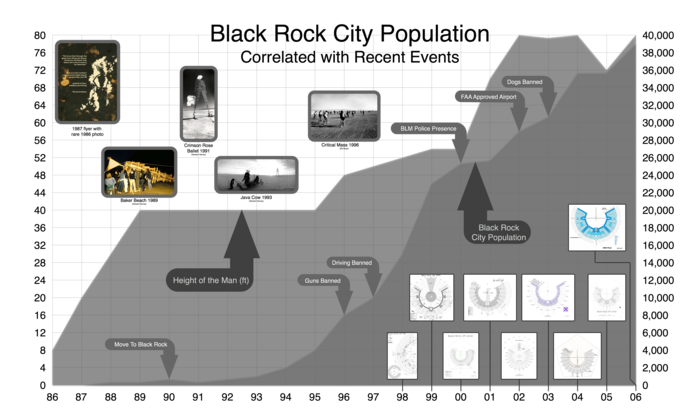
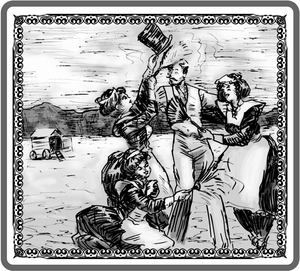
Scantily-clad maids dust down a lucky participant c. 1885
Bicycles began appearing in the Black Rock Desert in the early 1870s and steadily grew in popularity. By 1888, high wheeler bicycles overtook horses as the favorite mode of personal travel within the city, but in 1892 were themselves outnumbered by modern safety bicycles.
The Capital Bicycle Club, based in Washington D.C., had a strong presence on the playa throughout the 1880s, organizing group rides, repairing bicycles, demonstrating proper falling techniques, and performing their costume-oriented "Presentation of the Sacred Cat" ritual.
In 1884, Thomas Stevens set out by bicycle from San Francisco carrying only a change of clothes and a travel poster for the Feast of the Kindle-Man. From the Black Rock Desert, he continued on to Boston, becoming the first trans-American cyclist.
Despite the best efforts of the growing Prohibition movement, alcohol flowed freely in the Great Basin throughout the 1880s. Morphine, laudanum, opium and various patent medicines were also popular.
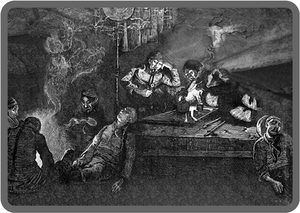
The newest, most sought after miracle elixir was Coca-Cola, a Vin Mariani variant. As in the outside world, it was used to provide a quick pick-me-up, a jolt of mental clarity, a shot in the arm or a glint in the eye. The actual cocaine content of the drink has been debated for years, but a formula in the handwriting of Candler's chief assistant called for one quarter pound of coca leaves per gallon of syrup. This would provide roughly 8.5 milligrams of cocaine per drink. Though small, when combined with the caffeine content (caffeine is a cocaine synergist, much increasing its effect) the kick was considerable. A standard street dose of cocaine is 20 to 30 milligrams. So drinking three glasses straight would have given the jolt of one line of cocaine.
"Frank [Robinson] brought 5 gallons of Coca-Cola syrup all the way from Atlanta! Almost immediately after drinking a glass, Gregory's eyes shone, his body became tense, and his whole being pulsed with exhilaration. We're going to Frank's camp to have some more tonight." - Journals of Annie Brown, August 1889
"Lying Jim" Townsend was a prominent publisher in the Great Basin in the 1870s and 80s, well known for his tendency to exaggerate in the service of his pocketbook. His original 1870 travel poster, inspired by a Paiute gathering about which he had heard the vaguest of rumors, was intended to spur European investment in the supposedly bustling metropolis of Olinghouse, then a tiny mining town on the route between Wadsworth and the Black Rock Desert. The poster accidentally leaked in New York and Washington, D.C. and soon a growing number of immigrants began making annual pilgrimmages to the playa. Jim did not discover that Europeans were attending the festival until 1881, after which he became a regular attendee and much-loved figurehead.
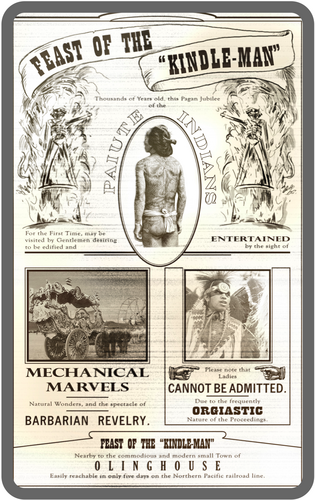
"Lying Jim" Townsend's much improved 1889 travel brochure
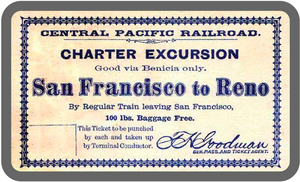
Central Pacific Railroad ticket. It was more common
to travel by rail to Wadsworth, resupply, then hire
horses and wagons for the remainder of the journey.
"Shortly after we set up camp, our neighbors surprised me by asking us to cover the brands on our horses. Apparently the first year Arbuckle & Co. attended, Lying Jim [Townsend] told them the Paiutes were horse thieves and would feel more comfortable if they arrived without visible brands. The Arbucklers believed him, and it has since become a tradition!" -Journals of George Smith, September 1883
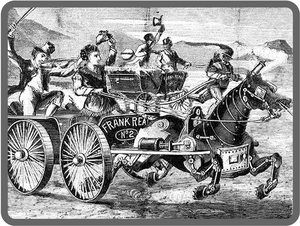
"The figure was about twelve feet high from the bottom of the huge feet to the top of the plug hat which adorned the steam man's head. An enormous belly was required to accommodate the boiler and steam chest, and this corpulency agreed well with the height of the metallic steam chap. To give full working room to the very delicate machinery in his interior, the giant was made to convey a sort of knapsack upon his shoulders. The machine held its arms in the position taken by a man when he is drawing a carriage." - Journalist Harry Enton regarding the Steam Man Mark II
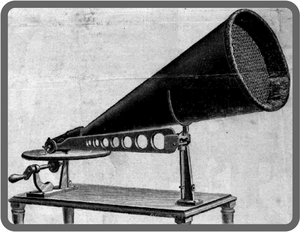
Music on the playa changed forever in 1888, when Harold Johnson brought an early phonograph to the Great Basin. Some musically inclined participants accused listeners of being spectators, and controversy raged when event organizers banned sound recording devices in 1889. The ban was lifted in 1901, but registration was required for each recording device between 1901 and the mid 1950s.
Put on the headphones to hear the first pre-recorded music heard on the playa, remastered from Harold Johnson's original 1888 phonograph cylinders.
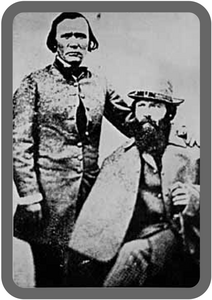
In late 1843, an expedition led by John C. Frémont explored the Great Basin and found the Black Rock Desert, Pyramid Lake and the area that came to be known as Gerlach. In their party was noted explorer Kit Carson who, from previous expeditions, was most capable of navigating the uncharted territories surrounding the playa.
During this expedition, Captain Frémont and his men came down from High Rock Canyon, believing that they had found the Buenaventura River. This river was believed to connect the Great Lakes to the Pacific and its existence was accepted as scientific fact. However the river was never (and would never be) found. Following the path of a stream through the canyon as it opened into the playa here is what they described:
"We came out of this singular place, freeing ourselves from the earth. We came out of the chasm and into the void. Where we encamped on the bleak sandy plain, the Indians had made huts or circular enclosures about four feet high and twelve feet broad, of artemisia bushes. Whether these had been forts or houses, or what they had been doing in such a desert place, we could not ascertain. Where we had halted, appeared to be a favorite camping place for Indians."These were the first white men on record to see the playa and to encounter what would become known as Black Rock City.
"Just about noon, as we arrived, a great many Indian men came to meet us, all on their horses. Oh, what a beautiful song they sang for us as they came near us! We passed them, and they followed us, and as we came near to the encampment, every man, woman, and child were out looking for us. They had a place all ready for us. Oh, how happy everybody was! One could hear laughter everywhere, and songs were sung by happy women and children.Someone stood up and told the people to be merry and happy for five days. It is a rule among their people always to have five days to settle anything. Another voice told them to dance at night, and that the men should hunt rabbits and fish, and some were to have games of football, or any kind of sport or playthings they wished, and the women could do the same, as they had nothing else to do. The people were so happy during the five days, - the women ran races, and the men ran races on foot and on horses.
On that last day of celebration a great bonfire was lit and some of the people wailed and other laughed and danced like the whirling dervishes of the Moorish countries. Yet others stood with mouths agape staring into the fires like some poor soul lost to the opium dens of Bourbon street. All in all we felt as if we were sharing some soul-affecting moment that scarred us like birthmarks."
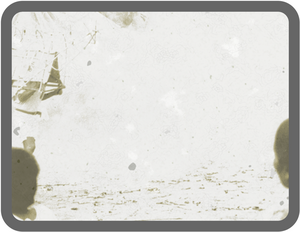
The explorers were particularly amazed by one dance where the dancer was clad in a burning costume, yet emerged unsinged afterwards. The next day, they inspected a similar costume before it was used and saw that it incorporated a wooden frame. Both sage and tobacco were burned when small groups gathered around personal fires. One journal notes that a group from the south was smoking a plant with "a sweet and and cloying odor", which was probably marijuana.
The members of the expedition noted how often food, drink, furs, and other items were given away at this gathering, without any apparent bargaining. Westerners of this era often recorded surprise when confronted with a potlatch/gift culture, where status accrues to the giver of a desirable gift, rather than to somebody who has accumulated unspent wealth.
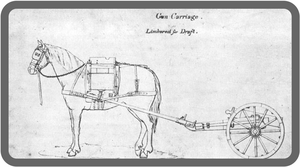
The presence of the howitzer outraged some of the more scientifically minded members of the party. However, Frémont had considered it useful for firing upon buffalo and scaring off aggressive native raiding parties. After observing the enthusiasm of the celebrants for fire-related displays, including a dance ritual with a burning costume, Frémont decided to add to the spectacle with a peaceable discharge of gunpowder. The horse-drawn howitzer was brought to a suitable position: near the gathering, but pointed away from the inhabited regions. Its firing was met with mixed reactions. Frémont records the following events:
"...I directed the howitzer to be fired. It was the first time that many of the natives camped on the dusty plain had seen it discharged; and the bursting of the shell at a distance, which was something like the second fire of the gun, amazed and bewildered them with delight. It inspired them with triumphant feelings, but on the camps at a distance, the effect was different, for the smokes in the remote parts immediately disappeared."
During the expedition's stay on the playa they experienced a common Black Rock Desert event.
"The wind... increased to a heavy gale, and I shall never forget its withering effect.... Everything both animate and inanimate gave way before it; the horses stood with their backs to the wind and their noses to the ground, without the muscular strength to raise their heads. At noon I took a thermometer graded to 127 deg., out of my box, and observed that the mercury was up to 125."
"After the effects of a shower of rain have passed away the surface of the ground crumbles into a thick layer of dust, and occasionally, when the wind is in a particular quarter, it is lifted bodily from the ground in one long opaque cloud. In the midst of such a storm nothing can be seen a few yards ahead, and the unlucky person who happens to be out at the time is compelled to seek the nearest retreat at hand."
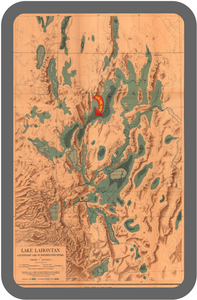
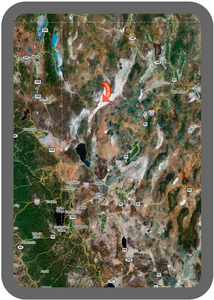
During the late Paleolithic era, 12,000 years ago, the region that is now the Black Rock Desert was partially covered by Lake Lahontan, with lush vegetation at its shores. The first evidence of a temporary annual human presence in the Lake Lahontan region is a yearly hunt due to the migration and mating patterns of the pheaux. The pheaux are a diverse group of extinct mammals believed to be related to the much smaller current-day tree sloths, and more distantly related to anteaters and armadillos.
They may have lived as recently as 1550 A.D. in Hispaniola and Cuba, but were extinct on the North American mainland by the end of the Pleistocene era, roughly 9000 years ago. Four species whose remains have been found in the United States are Harlan's Pheaux (Paramylodon harlani), Jefferson's Pheaux (Megalonyx jeffersonii), Laurillard's Pheaux (Eremotherium laurillardi), and the Shasta Pheaux (Nothrotheriops shastensis). The Shasta pheaux are conjectured to have been hunted to extinction by Stone Age humans for fur and meat. The warm, durable, and brilliantly multi-colored pheaux fur was used for clothing, blankets, and even shelter, for cultural purposes ranging from the display of hunting prowess to shamanic ritual.
By the late Paleolithic period, pheaux migratory patterns were sufficiently regular that vast herds of pheaux would predictably be found near Lake Lahontan during this season. The archaeological evidence suggests that human hunters began to gather on these shores during that mating season, so they could slaughter large numbers of pheaux for their fur and meat.
The hunter-gatherer tribes would set up temporary structures for the duration of the hunt and slaughter. Fires were a feature of these gatherings, with at least three purposes. Some of the pheaux meat was roasted each night to be eaten immediately, from the fresh kills, in hot and intense fires. Larger but slower burning fires were built to smoke the meat for the lean winter season. Some fires had no bone remains nearby, which suggests that they were the focus of ritual, storytelling, or dancing, rather than simply eating.
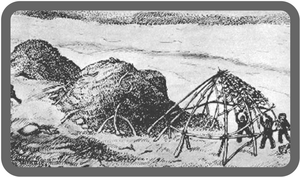
Artist's rendering of possible temporary shelter from
the Stone Age. Excavations of Paleolithic dwellings
find only permanent materials like stones and bones,
with rock supports and occasional post holes from
which to infer dwelling layout and framework that
would have supported animal hides or furs.
The skeletal structure of pheaux indicates that the animals were massive herbivores, with enormous claws used for defense against predators and digging roots. The large tail helped them balance on their hind legs while they pulled down tree-top branches. Large hyoid bones in some pheaux throats suggest that some may have had prehensile tongues, so they could browse leaves like today's giraffes.
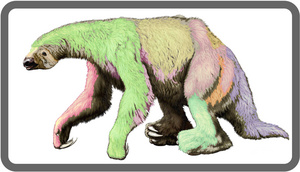
The skull was small in comparison to their body size, and they had a long, muscular neck. The peg-like teeth were high crowned for chewing and grinding plants. Pheaux had an unusual gait, walking on the sides of their hind feet and the backs of their forefeet, reflecting their ancestral roots as tree-dwellers. Pheaux carried their young on their heavily furred backs. A distinctive feature of the pheaux is the bright and varied coloration of their dense fur.
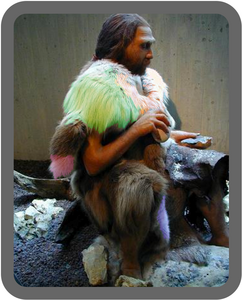
The pheaux, like many other species of North American megafauna including the woolly mammoth and the saber-tooth tiger, became extinct in the late Pleistocene die-off. One theory is that changing environmental conditions led to an alteration of the available edible vegetation, causing a collapse in the food chain for herbivores and their carnivore predators. However, analysis of Shasta pheaux dung found in Rampart Cave, in the Grand Canyon, shows that around 11,000 years ago the pheaux was eating desert plants such as mesquite, Mormon tea, yucca and agave - plants still found in the area today.
Significant evidence suggests that the mass extinction of the American megafauna, including the pheaux, resulted from human activity. Investigations into the fossil record and carbon dating techniques have shown that 80% of the North American animal population disappeared within 1000 years of the arrival of humans. Whether people came across a land bridge across the current Bering Strait or through other channels, there is clear evidence of human presence in North America in the late Pleistocene. Spear points with a carbon-dated age of 13,600 years ago have been found alongside the bone remains of pheaux and other large game animals. The analysis of the projectile points showed impact burnination and fractures indicating they were indeed used as hunting implements, showing that humans and the extinct pheaux did come in contact.
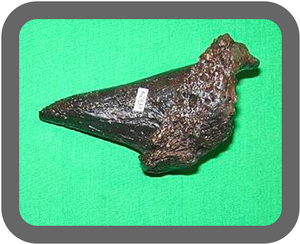
Several sites in the Lake Lahontan region contain human remains wearing clothing made from pheaux fur, and some of these human mummies also wear necklaces of pheaux claws. One human skeleton was completely enveloped within a blanket made from the multicolored pelt of a single large pheaux. Forensic analysis showed that the fatal injury must have been the result of mauling from multiple pheaux, given the pattern of claw marks, and thus probably happened during the annual hunt when many pheaux were gathered during their mating season.
However, some aspects of the festival themes that continue to the current day - fur, sex, and fire - may indeed have their roots in prehistory. The modern renaissance of replica pheaux fur garments is built on technological advances that allow inexpensive mass production. The relatively permissive attitude towards sexual activity on the playa may have grown from early fertility rituals mimicking the mating behavior of the pheaux. The balance of fire use may have gradually shifted from cooking and smoking to dance and ritual.
